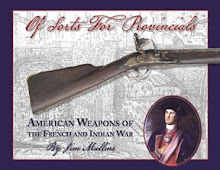 a collection of coins commonly found at F&I era British sites (half pennies, pistareens)
a collection of coins commonly found at F&I era British sites (half pennies, pistareens)
with a 20 shilling Virginia note from 1757 and coin scales.
What kinds of money were provincial soldiers paid with? Judging from excavated materials, Pistareens and half pennies ( http://www.coins.nd.edu/ColCoin/ColCoinText/Br-Copper.2.html )were in wide circulation during this period. Early on in the conflict General Braddock brought over large quantities of Spanish silver “Piastrines” (a Pistareen or 2 reales being worth 15 d) from England Washington Portugal Philadelphia
Some links:
http://www.coins.nd.edu/ColCoin/index.html
http://data.numismatics.org/cnl/Pistareens.pdf
http://www.coins.nd.edu/ColCurrency/CurrencyIntros/IntroValue.html
Some links:
http://www.coins.nd.edu/ColCoin/index.html
http://data.numismatics.org/cnl/Pistareens.pdf
http://www.coins.nd.edu/ColCurrency/CurrencyIntros/IntroValue.html
